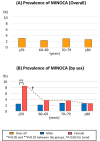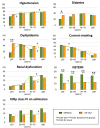Clinical Characteristics and Outcome of Patients With Myocardial Infarction With Nonobstructive Coronary Arteries in Japan: Insights From the Miyagi Acute Myocardial Infarction Registry Study
- PMID: 39968798
- PMCID: PMC12132692
- DOI: 10.1161/JAHA.124.036802
Clinical Characteristics and Outcome of Patients With Myocardial Infarction With Nonobstructive Coronary Arteries in Japan: Insights From the Miyagi Acute Myocardial Infarction Registry Study
Abstract
Background: Clinical characteristics and outcomes of patients with myocardial infarction (MI) with nonobstructive coronary arteries (MINOCA) are not fully understood, particularly in Japan.
Methods and results: We enrolled a total of 8881 patients with acute MI from the Miyagi Acute Myocardial Infarction Registry Study (2012-2020), with a median age of 69 years. Among them, 239 patients (2.7%) were diagnosed with MINOCA. Compared with those with MI with obstructive coronary artery disease (MI-CAD), patients with MINOCA were more often women, had a higher incidence of non-ST-segment-elevation MI and a lower prevalence of dyslipidemia. Compared with patients with MI-CAD, patients with MINOCA in all age groups (<59, 60-69, 70-79, >80 years of age) had a higher incidence of non-ST-segment-elevation MI. Additionally, those ≤59 years of age were more often women and had a lower prevalence of diabetes and dyslipidemia. In-hospital mortality increased with age in patients with MI-CAD (3.9% for <59 years of age, 5.6% for 60-69 years of age, 8.3% for 70-79 years of age, and 15.2% for >80 years of age; P<0.01), but not in patients with MINOCA (4.5%, 7.4%, 6.0%, and 9.6%, respectively; P=0.36). Compared with patients with MI-CAD, patients with MINOCA had lower in-hospital mortality for Killip class IV (40.7% versus 20.0%; adjusted odds ratio [OR], 0.31 [95% CI, 0.10-0.94]; P=0.04) and renal dysfunction (20.0% versus 7.1%; adjusted OR, 0.29 [95% CI, 0.09-0.96]; P=0.04).
Conclusions: Patients with MINOCA exhibit distinct clinical characteristics and outcomes compared with those with MI-CAD, particularly in terms of age, sex, prevalence of comorbidities, and in-hospital mortality. These findings underscore the importance of tailored clinical approaches for patients with MINOCA.
Keywords: acute myocardial infarction; nonobstructive coronary artery; prognosis.
Conflict of interest statement
Dr Shimokawa received lecture fees from Bayer Yakuhin (Osaka, Japan) and Daiichi Sankyo (Tokyo, Japan). Dr Yasuda received grant support from Takeda Pharmaceutical, Abbott, and Boston Scientific; and lecture fees from Daiichi Sankyo and Bristol Myers Squibb. The remaining authors have no disclosures to report.
Figures




References
-
- Gehrie ER, Reynolds HR, Chen AY, Neelon BH, Roe MT, Gibler WB, Ohman EM, Newby LK, Peterson ED, Hochman JS. Characterization and outcomes of women and men with non‐ST‐segment elevation myocardial infarction and nonobstructive coronary artery disease: results from the Can Rapid Risk Stratification of Unstable Angina Patients Suppress Adverse Outcomes with Early Implementation of the ACC/AHA Guidelines (CRUSADE) quality improvement initiative. Am Heart J. 2009;158:688–694. doi: 10.1016/j.ahj.2009.08.004 - DOI - PubMed
-
- Baccouche H, Mahrholdt H, Meinhardt G, Merher R, Voehringer M, Hill S, Klingel K, Kandolf R, Sechtem U, Yilmaz A. Diagnostic synergy of non‐invasive cardiovascular magnetic resonance and invasive endomyocardial biopsy in troponin‐positive patients without coronary artery disease. Eur Heart J. 2009;30:2869–2879. doi: 10.1093/eurheartj/ehp328 - DOI - PubMed
-
- Hokimoto S, Kaikita K, Yasuda S, Tsujita K, Ishihara M, Matoba T, Matsuzawa Y, Mitsutake Y, Mitani Y, Murohara T, et al. JCS/CVIT/JCC 2023 guideline focused update on diagnosis and treatment of vasospastic angina (coronary spastic angina) and coronary microvascular dysfunction. Circ J. 2023;87:879–936. doi: 10.1253/circj.CJ-22-0779 - DOI - PubMed
Publication types
MeSH terms
LinkOut - more resources
Full Text Sources
Medical
Miscellaneous

